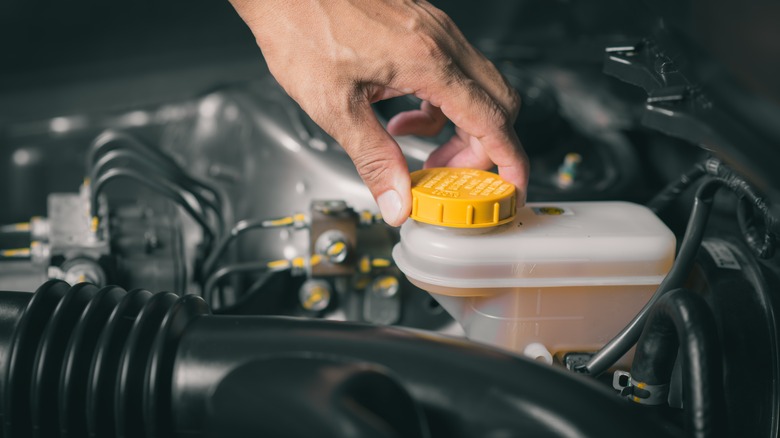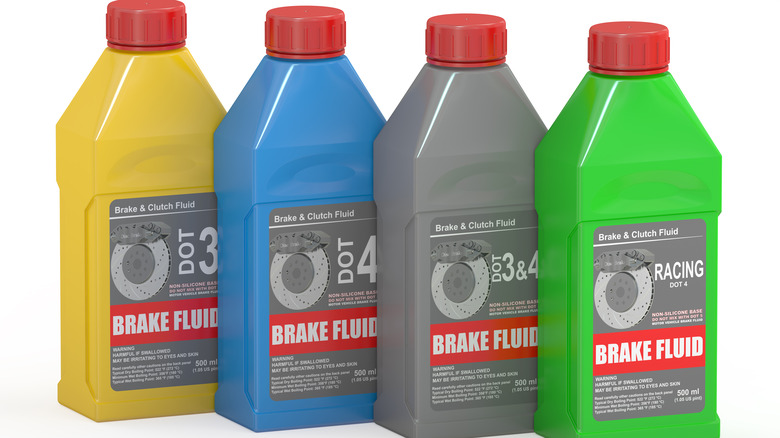How Often Do You Really Need To Change Your Car's Brake Fluid?
Modern cars require periodic maintenance, and brake fluid is one of the most neglected aspects. Like the engine oil, coolant, and transmission fluids, the brake fluid in your car needs replacing every so often to deliver reliable stopping power. As a general rule, changing the engine oil every 5,000 to 7,000 miles applies to engines using full synthetic or semi-synthetic oil, and doing so prevents early wear and the formation of harmful sludge.
Meanwhile, cars with an automatic gearbox should have an ATF (automatic transmission fluid) flush every 60,000 to 100,000 miles, but the actual numbers would depend on the make and model of your car. The owner's manual will reveal everything you need to know about when to change the engine oil and ATF, but what about the brake fluid?
Honda claims the brake fluid in its cars should last four to five years "under normal circumstances," but the mileage may vary for vehicles driven in extreme weather or daily bumper-to-bumper traffic. Most enthusiastic owners would focus heavily on maintaining the engine, paint, tires, and gearbox. Moreover, people only notice defective braking when worrying symptoms start to appear, but the truth is regular brake fluid changes will prevent most braking problems from the onset.
What is brake fluid?
Brake fluid is a hydraulic fluid with hygroscopic properties, which absorbs moisture from the air and its surroundings. The brake fluid could get contaminated by dirt and water from humidity in the air, and the fluid breaks down when exposed to repeated bouts of extreme heat or cold. As the brake fluid ages, drivers could expect diminished braking performance and a spongy brake pedal feel, a sure sign of brake fluid contamination.
Brake fluids come in many types, but the most commercially available ones are DOT 3, DOT 4, DOT 5, and DOT 5.1. The type of brake fluid depends on your vehicle, but most cars require DOT 3 or DOT 4. DOT3 brake fluid is ether-based, while DOT 4 mixes glycol ether with borate ester. Moreover, you can mix DOT 3 with DOT 4 and vice-versa, but DOT 4 has a higher boiling point than DOT 3, and using pure DOT 4 will give better braking performance. Meanwhile, DOT 5 brake fluids are silicone-based and are more suitable for motorcycles.
When to change the brake fluid
It's a good idea to flush the old brake fluid whenever the car requires brake servicing, like changing brake pads or rotors. Furthermore, inspecting the level and condition of the brake fluid at every oil change is good practice. If the brake fluid in the reservoir is dirty or brownish (fresh brake fluid has a clear appearance) or if symptoms like a soft brake pedal feel, an illuminated ABS warning light on the dashboard, or ineffective braking are noticeable, have the brake system checked and have the fluid replaced whenever possible.
How quickly your car stops is more critical than how fast it goes. Refer to your car's owner's manual to learn more about the brake fluid type, the location of the reservoir, and the correct brake fluid level for your ride. Do not wait for the brake fluid to turn dirty or for the brake pedal to feel soft and spongy. Have the brake fluid inspected and replaced every two years or 30,000 miles to ensure a safer and more reliable braking system.



